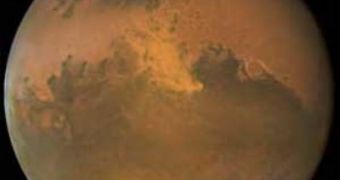The atmosphere on Mars is thinner than the one on Earth, with a surface pressure less than 1 percent that on Earth, but it is quite dusty. This doesn't prevent the planet from experiencing the largest dust storms in our solar system.
Now, a gigantic storm is covering large areas of the surface, having the potential to cover the entire planet. These storms appear when the planet is closest to the Sun, which increases the overall temperature and produces huge winds that lift the dust into the atmosphere.
For now, NASA scientists don't know how large the storm will get, only that it's thousands of miles in diameter. If it follows the patterns of previous storms, it could grow, possibly becoming a threat to the two missions on the surface, Mars Spirit and Opportunity.
The latest observations of the planet show a large spot that blocks the sunlight from reflecting of the surface for almost six days. However, there is one positive aspect of the storm, the fact the growing winds have blown off much of the dust deposited on the solar arrays of thee rovers, thus boosting their power production.
This may even help the Opportunity to descend into Victoria Crater, but mission control is still analyzing this possibility.
"We've been watching this storm for about six days now," said Steven Squyres of Cornell University, lead scientist of the Mars Exploration Rover Project. "It's not unheard of for Martian dust storms to cover half the planet, and this one is now a regional storm."
Presently, the storm is only blowing off dust around 900 km (560 mi) east of the rover, located at Meridiani Planum and officials are concerned that if it gets closer, the dust it would deposit might prevent Opportunity from using its solar arrays to produce electricity.
"The Mars Reconnaissance Orbiter team is watching this closely, because we worry about dust in the atmosphere obscuring the sunlight," Squyres said. "If the storm continues to get worse, it could cut into our activities."
A 2001 storm was so violent that it eventually engulfed the entire surface of the planet in a massive cloud of dust.

 14 DAY TRIAL //
14 DAY TRIAL //